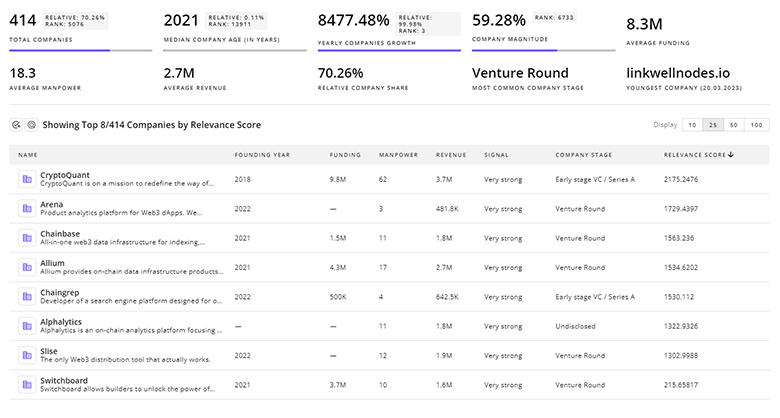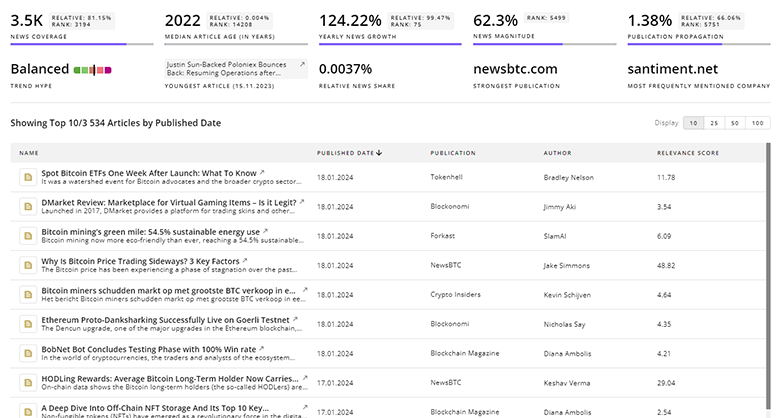
Early Diagnosis Report
: Analysis on the Market, Trends, and TechnologiesThe early diagnosis market reached USD 1.1 billion in 2024 and is forecast to grow at a 15.6% CAGR to approximately USD 2.6 billion by 2030, indicating rapid commercialization of multi-disease screening platforms and liquid biopsy workflows. This growth reflects three converging dynamics in the data available: high clinical promise for earlier detection (for example, population models project up to five additional healthy years through wider adoption of early diagnostics), accelerating private investment into AI diagnostics and MCED tests, and expanding point-of-care and at-home testing options that compress turnaround time and widen access.
This article was last updated 63 days ago. If you find any info is missing, let us know!
Topic Dominance Index of Early Diagnosis
The Dominance Index of Early Diagnosis looks at the evolution of the sector through a combination of multiple data sources. We analyze the distribution of news articles that mention Early Diagnosis, the timeline of newly founded companies working in this sector, and the share of voice within the global search data
Key Activities and Applications
- Population screening and asymptomatic multi-cancer programs using liquid biopsy (ctDNA, methylation and proteomic panels) for early identification and post-treatment recurrence surveillance.
- AI-driven triage and risk-scoring applied to EHRs and longitudinal data to prioritize patients for targeted tests, increasing detection rates for cancers with no routine screening (e.g. pancreatic cancer) and internal trend data on AI adoption.
- Point-of-care and kiosk models that deliver rapid biochemical or immunoassay results with integrated telemedicine follow-up, lowering barriers in underserved settings and reducing outpatient load Diagnostic Testing Market 2025 Driven by Early Diagnosis.
- Neurodegenerative presymptomatic screens (blood biomarkers, retinal scans, imaging + AI) for earlier intervention and trial enrolment and news reporting of high-accuracy Alzheimer's blood tests in development.
- Rapid infection and sepsis prediction tests that detect physiological or molecular signals days before clinical deterioration, enabling proactive inpatient management and point-of-care rapid diagnostics.
Why this matters: these activities shift value from late-stage, high-cost interventions to earlier, lower-cost care pathways that can improve outcomes and reduce downstream spending—creating a clear payer and health-system incentive to adopt validated tests.
Emergent Trends and Core Insights
- Platform consolidation around multi-modal diagnostics: market signals show movement from single-test vendors to integrated platforms that combine liquid biopsy, imaging, and AI analytics to improve positive predictive value and care coordination.
So what: integrated platforms simplify reimbursement negotiations and clinical integration because they deliver end-to-end workflows rather than isolated data points. - Blood-based MCED and multi-analyte panels scale quickly; leading MCED approaches now cover more than 50 cancer types and return results within 48 hours in some workflows, driving payer attention and pilot coverage decisions Avalon 2025 Lab Trend Report.
So what: fast, broad-coverage tests make population screening feasible and force radiology and oncology operations to redesign diagnostic pathways for confirmatory workups. - AI as a clinical triage layer shows measurable uplift in early detection: risk models trained on multi-institution EHRs identify high-risk cohorts for targeted screening (example: PRISM for pancreatic cancer improved case capture from ~10% to 35% in retrospective evaluation).
So what: AI prioritization reduces unnecessary testing and focuses scarce diagnostic capacity where incremental yield is highest. - Reimbursement and regulatory inflection points shape commercialization: policy moves (e.g. Medicare MCED Coverage Act, EU Cancer Plan) and selective payer coverage expand addressable markets but increase demand for large-scale clinical validation and health-economic evidence.
So what: market access strategies must tie clinical utility to cost offsets; companies without payer-grade evidence face adoption headwinds. - Decentralized, low-cost sampling (breath, urine, at-home finger-prick) widens screening reach but raises specificity management issues—False positives in low-prevalence populations require efficient confirmatory pathways to avoid overloading imaging and specialty services and internal diagnostics data.
So what: business models that bundle confirmatory diagnostics and navigation (lab + clinician referral) will capture more value than pure screening providers.
Funding note (integrated): total funding observed across the early-diagnosis topic in the internal data aggregates to multi-billion dollar commitments, and capital flows concentrate in MCED, AI analytics, and point-of-care device scale-up (integrated funding figures taken from the funding synthesis included in the internal data).
Technologies and Methodologies
- AI and ML for predictive risk scoring and image/omics pattern recognition, applied as a front-end triage and second-read support for clinicians and demonstrated in large EHR models for PDAC risk.
Implication: adoption depends on model generalizability, explainability, and EHR interoperability. - Liquid biopsy modalities: cfDNA/ctDNA methylation profiling, targeted NGS, digital PCR and multi-analyte proteomic panels for early oncology detection.
Implication: sensitivity at early stages remains the technical bottleneck; assays that raise sensitivity without losing specificity unlock population screening economics. - High-sensitivity protein assays and multiplex immunoassays used for neuro and cardiac early detection (pTau217, hs-cTnI) and multi-marker cardiac rule-outs [News Landscape; Polymedco PATHFAST hs-cTnI-II clearance reported in industry events].
- Non-invasive biosensing: breath VOC analysis and portable retinal imaging paired with onboard AI enable at-home or community screening and retinal disease screening examples reported in clinical pilots.
- Microfluidics, lab-on-chip and rapid molecular amplification (isothermal LAMP, plasmonic PCR) that enable point-of-care sample-to-answer workflows for infectious and oncologic screening.
Systemic consequence: devices that integrate sample prep, analytics and cloud-based reporting will scale fastest because they match clinical workflows and minimize training.
Early Diagnosis Funding
A total of 498 Early Diagnosis companies have received funding.
Overall, Early Diagnosis companies have raised $8.8B.
Companies within the Early Diagnosis domain have secured capital from 2.0K funding rounds.
The chart shows the funding trendline of Early Diagnosis companies over the last 5 years
Early Diagnosis Companies
- EarliTec Diagnostics, Inc. — EarliTec commercializes EarliPoint™, an FDA-authorized tool for objective autism assessment in children 16 to 30 months old. The company uses AI-enabled behavioral and sensor data to accelerate diagnosis and triage for early intervention, addressing a known clinical delay in neurodevelopmental diagnosis; EarliTec is in Series B with meaningful clinical validation and commercialization traction.
Why notable: the product integrates into pediatric workflows and converts behavioral observation into scalable, reimbursable diagnostics, reducing diagnostic latency and enabling earlier therapy initiation. - Definitive Diagnostics, Inc. — Definitive Diagnostics develops an AI-enhanced blood protein pattern platform that reports very high sensitivity and specificity claims (97–99%) across selected cancer types, including stage-1 detection performance; the company focuses on automated, scalable lab workflows and claims high accuracy for tissue-of-origin determination.
Why notable: if independently validated, this level of analytic performance compresses confirmatory cascades and makes payer conversations about broad screening more tractable. - SpotitEarly — SpotitEarly offers a breath-based, at-home pre-screen that detects multiple cancer types from VOC signatures with reported ~94% combined accuracy in early studies and a direct-to-consumer sampling model that reduces access friction.
Why notable: breath sampling eliminates phlebotomy infrastructure and supports high-frequency population screening, but success depends on integration with efficient confirmatory pathways to manage false positives. - Presymptom Health — Presymptom develops patented AI blood tests designed to predict sepsis and infections up to three days before symptom onset, positioning the product for acute care and antimicrobial stewardship applications; the company targets lab-instrument compatibility for rapid rollout.
Why notable: early sepsis prediction can materially reduce ICU utilization and mortality; commercial uptake depends on integration with inpatient workflows and demonstration of actionable lead time. - 4D Lifetec AG — 4D Lifetec markets an AI-enhanced immunological high-throughput blood test (4D Lifetest™) aimed at stage I-II cancer detection with CE-IVD ambitions and a cost-effective lab assay design to enable population screening.
Why notable: European certification and a lab-scale, high-throughput business model position the company to serve national screening pilots and commercial lab networks.
(Each company description above draws on the company records in the dataset cited at the end of the corresponding bullet.)
Uncover actionable market insights on 1.8K companies driving Early Diagnosis with TrendFeedr's Companies tool.

1.8K Early Diagnosis Companies
Discover Early Diagnosis Companies, their Funding, Manpower, Revenues, Stages, and much more
Early Diagnosis Investors
Get ahead with your investment strategy with insights into 1.8K Early Diagnosis investors. TrendFeedr’s investors tool is your go-to source for comprehensive analysis of investment activities and financial trends. The tool is tailored for navigating the investment world, offering insights for successful market positioning and partnerships within Early Diagnosis.

1.8K Early Diagnosis Investors
Discover Early Diagnosis Investors, Funding Rounds, Invested Amounts, and Funding Growth
Early Diagnosis News
TrendFeedr’s News feature offers access to 9.8K news articles on Early Diagnosis. The tool provides up-to-date news on trends, technologies, and companies, enabling effective trend and sentiment tracking.

9.8K Early Diagnosis News Articles
Discover Latest Early Diagnosis Articles, News Magnitude, Publication Propagation, Yearly Growth, and Strongest Publications
Executive Summary
Early diagnosis stands at a commercial and clinical inflection point where improved assay sensitivity, AI-based prioritization, and decentralized sampling combine to change how healthcare systems find disease. The economic case centers on shifting spend upstream: validated early detection reduces late-stage treatment costs and improves outcomes, which aligns stakeholder incentives when regulatory and payer evidence thresholds are met. Practically, winners will pair high analytic performance with clear confirmatory pathways and payer evidence; platform players that integrate screening, navigation, and downstream diagnostics will capture the largest share of care pathways. Operators focused on niche, high-value clinical gaps—such as presymptomatic sepsis or neurodevelopmental screening—can scale through targeted reimbursement wins or strategic partnerships with larger diagnostic platforms. Overall, the commercial opportunity favors companies that prove clinical utility at scale and embed their tools into clinician workflows rather than relying on stand-alone screening alone.
Have expertise in trends or technology? Your input can enrich our content — consider collaborating with us!










